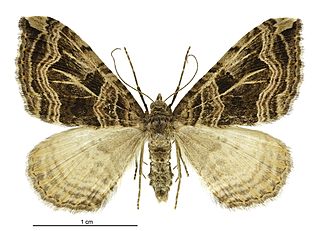
Xanthorhoe semifissata, commonly known as the barred pink looper. is a moth of the family Geometridae. It is endemic to New Zealand and is found throughout the country although it is much less common in the mountains in the south and west of the South Island. The larvae host plants include Nasturtium officinale as well as species in the Cardamine genus. Adult moths inhabit shrubs at the edge of native forest.

Xyridacma is a genus of moths in the family Geometridae erected by Edward Meyrick in 1888.

Austrocidaria parora is a species of moth of the family Geometridae. It is endemic to New Zealand.
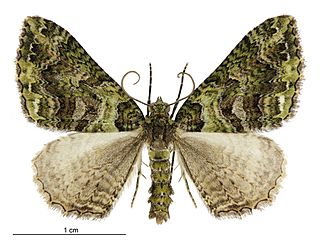
Austrocidaria similata is a species of moth of the family Geometridae. It endemic to New Zealand.

Heterocrossa contactella is a species of moth in the family Carposinidae. It is endemic to New Zealand and can be observed in both the North and South Islands. The preferred habitat of this species is native forest and scrub, especially where Leptospermum shrubs are found. Adults are on the wing in December and January.

Heterocrossa eriphylla, also known as the lichen snoutlet moth, is a species of moth in the family Carposinidae. It is endemic to New Zealand and is found in the North Island and the northern parts of the South Island. This species is regarded as relatively uncommon and inhabits native forest. The larvae feed on the healing wounds of New Zealand beech trees Fuscospora fusca and Fuscospora truncata. It pupates at its feeding site and emerges from December onward. The adult moth is nocturnal and is attracted to light. During the day the moth rests on lichen covered tree trunks where their lichen mimicking colouration assists with their camouflage.

Pterophorus furcatalis, the Pittosporum plume moth, is a moth of the family Pterophoridae. It was first described by Frances Walker and is endemic to New Zealand. This species can be found throughout the North, South and Stewart Islands. Its preferred habitat is dense native bush. Larval host plants include Pittosporum eugenioides and Pittosporum crassicaule. Adult moths are on the wing from November to March and are attracted to light.

Pasiphila bilineolata is a moth in the family Geometridae. It is endemic to New Zealand and can be found in the North and South Islands. The species inhabits native forest and shrubland and the larvae feed on Hebe species. Adults are on the wing commonly from August to January but have been observed most months of the year and are attracted to light.
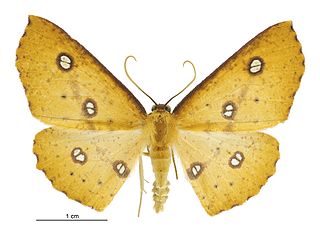
Xyridacma alectoraria is a moth of the family Geometridae. It was described by Francis Walker in 1860 using a specimen collected in Auckland. It is endemic to New Zealand. This species is regarded as being rarely observed.
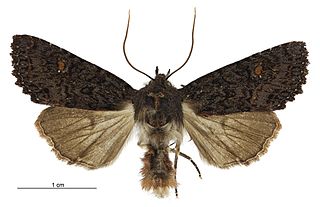
Meterana vitiosa is a moth of the family Noctuidae. It was described by Arthur Gardiner Butler in 1877 from specimens collected by Dr Hector and Mr J. D. Enys in the South Island. It is endemic to New Zealand. The habitat this species prefers consists of forests and shrub-land areas. Adults are on the wing throughout the year.

Asaphodes abrogata is a moth in the family Geometridae. It is endemic to New Zealand and can be found from the central North Island as well as the South Island. This species is inhabits open country at altitudes of between 2000 and 4000 ft. Larvae have been reared on Plantago species including Plantago coronopus. It has been recommended that Plantago raoulii be planted to attracted this species. Adults are on the wing in February and March.

Arctesthes catapyrrha is a moth of the family Geometridae. It is endemic to New Zealand.
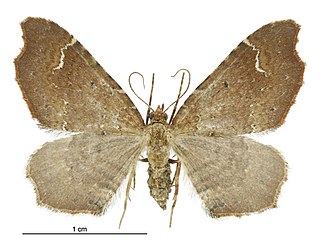
Asaphodes camelias is a species of moth in the family Geometridae. It is endemic to New Zealand, has been observed in both the North and South Islands and inhabits native forest. The adults of this species are on the wing from February to May and July to September.
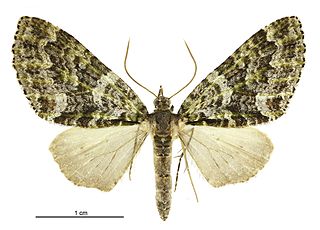
Tatosoma agrionata, also known as the mistletoe carpet moth, is a species of moth in the family Geometridae first described by Francis Walker in 1862. It is endemic to New Zealand. It is classified as at risk, declining by the Department of Conservation.

Samana acutata is a species of moth in the family Geometridae This species is endemic to New Zealand. It is classified as "At Risk, Relict" by the Department of Conservation.

Asaphodes clarata is a species of moth in the family Geometridae. This species is endemic to New Zealand and has been found on the North and South Islands. The species inhabits open grassy areas, including tussock grasslands, in montane habitat. The larvae feed on the leaves of Ranunculus species. The adult moths are day flying and are on the wing from December to February and have been shown to pollinate Celmisia laricifolia and Hebe pinguifolia.

Notoreas perornata is a species of moth in the family Geometridae. It is endemic to New Zealand and is found in the North Island from Northland to Westland as well as in the South Island on the coast of Marlborough.

Homoeosoma anaspila is a species of snout moth in the genus Homoeosoma. It is endemic to New Zealand. It found in the North and South Islands as well as the Kermadec Islands.

Xanthorhoe occulta is a species of moth in the family Geometridae. It is endemic to New Zealand and was first described by Alfred Philpott in 1903. It is found in the North, South and Stewart Islands. The adult moths are on the wing from
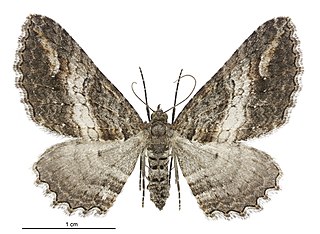
Horisme suppressaria is a moth of the family Geometridae. This species was first described by Francis Walker. Currently the taxonomy of this species is uncertain and as a result this species is also known as Horisme (s.l.) suppressaria. The species is endemic to New Zealand and has been observed in both the North and South Islands. The larval hosts of H. suppressaria are species in the genus Corokia including Corokia cotoneaster.





















